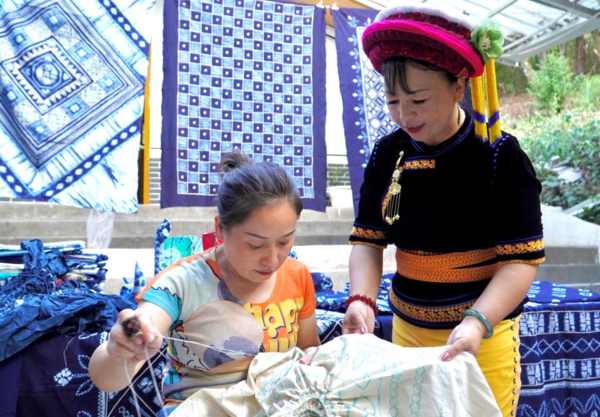Across China: Ethnic Bai Woman Travels Far to Promote Cultural Heritage
 |
| Zhang Pihe (R) teaches traditional tie-dyeing technique of the ethnic Bai group to a villager in Sangzhi County, central China's Hunan Province, Sept. 8, 2022. [Xinhua/Zhang Ge] |
CHANGSHA, Jan. 18 (Xinhua) — Crowds gathered around Zhang Pihe, watching how the Bai woman deftly folded and rolled the fabric and then wrapped it, stitch by stitch — an important step in the traditional tie-dyeing technique of the ethnic Bai group in China.
Hequn Village, in Furongqiao Bai Township of Sangzhi County, in central China's Hunan Province, has attracted many tourists recently with its rich Bai culture.
But Zhang, who was introducing visitors to Bai culture, is not a native of the village, her hometown is more than 1,000 km away in Dali, home to most of the country's Bai population, in the southwestern border province of Yunnan.
Over 700 years ago, an army of Bai people from Dali came to Hunan to set down roots in Sangzhi. In the 1980s, after a series of visits and investigational studies, authorities recognized that the Bai people of Sangzhi and those of Dali were of the same origin.
However, Sangzhi was once an impoverished county in Hunan Province, and the residents of Hequn Village were once too poverty-stricken and too busy making a living away from home to learn Bai culture. The Bai-style dance, for example, has more than 80 types of moves that are on the verge of being lost in Sangzhi.
Having been brought up and deeply influenced by the Bai culture, Zhang has studied Bai music, dance, tie-dyeing, and other traditional culture.
"We are all from a Bai village, so I hope we can work together to pass on and promote our culture," said Zhang. With such conviction in mind, Zhang left her hometown of Yunnan and moved to Sangzhi County.
"I hope to take advantage of the traditional cultural resources of the Bai ethnic group to boost the development of our villages," said Zhang.
As soon as Zhang arrived in Hequn Village, she set up the Bai tie-dyeing room, purchased needles, thread, cotton cloth, brushes, and other tools from Yunnan, and began training villagers in tie-dyeing techniques. She started with the Bai-styled octagonal drum and gave local Bai women a systematic lecture on the historical heritage of the music and dance of the Bai ethnic group, teaching each syllable and movement.
As a cultural advisor to the Bai cultural projects that will soon be implemented in the village, Zhang and the villagers committee developed a cultural heritage curriculum for the villagers.
Wang Yan, a girl from Hequn Village, said that the more she learns about the Bai culture, the more she loves it. "Ms. Zhang teaches us Bai music, dance, tea art, and handicrafts. As a member of the Bai ethnic group, I will keep these skills passed on!"
"The heritage of culture cannot be destroyed," said Zhong Baiyu, Party secretary of Hequn Village. Now that more and more people are returning to their hometowns, the Bai culture becomes even more of a "soft power" for revitalizing the area.
"Nowadays, the atmosphere of our Bai culture is getting stronger and stronger, and I have more confidence in passing on our Bai culture," said Wang.
 |
| Zhang Pihe shows traditional tie-dyeing technique of the ethnic Bai group in Sangzhi County, central China's Hunan Province, Sept. 8, 2022. [Xinhua/Zhang Ge] |
(Source: Xinhua)
Please understand that womenofchina.cn,a non-profit, information-communication website, cannot reach every writer before using articles and images. For copyright issues, please contact us by emailing: website@womenofchina.cn. The articles published and opinions expressed on this website represent the opinions of writers and are not necessarily shared by womenofchina.cn.








.jpg)

 WeChat
WeChat Weibo
Weibo 京公网安备 11010102004314号
京公网安备 11010102004314号